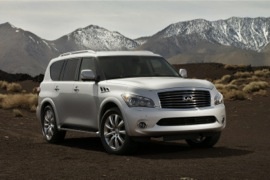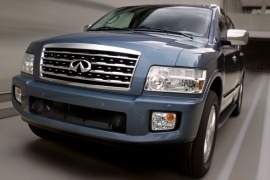
INFINITI QX
Generations Timeline, Specs and Pictures

Nissan developed a premium version for the rugged Patrol Y62 model and sold it on the U.S. market as a second-generation Infiniti QX56.
In 2010, at the New York Auto Show, Infiniti displayed its biggest model: the 2011 QX56. It competed against the Lexus LX 580 or the Cadillac Escalade. It was difficult for Nissan to hide the links with the Nissan Armada, but the exterior design and the luxurious interior made people forget and forgive that detail.
On the outside, the QX showed a polarizing design with a love-it or hate-it look. The massive chromed grille was taller than the headlights, while its curved angry-looking headlights on the front fenders showed no mercy for the cars in front of them. In the rear, the squared back with shaved margins featured a tall, power-operated liftgate.
Inside, the car featured an executive styling with wood trims on the dashboard, center stack, center console, and door panels. It could accommodate up to eight passengers, but most likely, it was configured for seven, with a middle bench seat for three. The infotainment system took the top spot on the center stack, between the vents. Even though it didn’t feature a touch-screen, it offered intuitive controls from the panel placed underneath it.
Under the hood, Nissan dropped a 5.6-liter V-8 fuel injected and with a cylinder deactivation system. It was paired as standard to a seven-speed automatic gearbox. Power went in all corners via a two-speed transfer case.

Infiniti entered the competition on the full-size SUV segment with the QX56 by following the same recipe used by Lincoln and Cadillac.
When the premium carmaker introduced the QX4 back in 1997, the SUV was criticized for being too small for a premium SUV. With the QX56, that didn’t happen. Nissan already produced a strong chassis used for the Titan and used it for its full-size SUV Armada. Then, it used the same base for the QX56.
When Masato Takahashi penned the vehicle, it made it with a big, easy-to-recognize front fascia. The car’s headlights didn’t fill all the height between the bumper and the hood’s edge. He positioned them lower. Between them, mounted on the front vertical part of the hood, he installed a chromed grille with four horizontal slats and the company’s logo in the middle. From its sides, the QX56 featured a unique C-pillar design, with the door handle masked inside. At the back, Infiniti made the liftgate with an independently opening rear windscreen.
Inside, the QX56 featured a seven-seat interior with a 2-2-3 layout. At the front, the tall and wide dashboard featured a center stack for the audio and climate control system, with the navigation display moved on the upper side. The instrument cluster was rounded and hosted a four-dial setup, with the speedometer and tachometer in the middle, flanked by the coolant temperature and fuel level gauges. Unlike other carmakers, Infiniti didn’t offer different trim levels; it installed everything right from the start, so no one complained about it. The leather-clad interior and the wood veneers were standard, and so was the backup camera too.
Under the hood, the carmaker installed the 5.6-liter V-8 unit paired with a five-speed automatic gearbox. The only option for the car was between the rear-wheel-drive or the all-wheel-drive system.

In 2000, Infiniti introduced a mid-life cycle refresh for its entry-level SUV, the QX40.
Nissan was determined to get a slice of the premium-segment and introduced the Infiniti brand with vehicles based on the regular Nissan models. The QX4 was based on the Nissan Terrano, and it was available with four-doors only. Its unit-body construction made it lighter than a regular SUV, but nevertheless was good in off-road use thanks to its standard, rugged Nissan drivetrain.
From the outside, the 2001 QX4 sported a new front fascia with the Infiniti logo on it. The lower part of the bumper featured new fog lights installed on the outer side scoops. Its headlights were redesigned and incorporated the turn-signals on their outer side. In the rear, the QX40 featured new taillights and a modified bumper design.
Inside, Infiniti insisted on creating a comfortable and premium interior. The leather seats and wood-trims were a must for the QX40, and so was the sound system. On the other hand, some features were fitted as an option, such as the sunroof or the navigation system. Unfortunately, Infiniti couldn’t resolve a problem mentioned on the Nissan Terrano: the QX40 carried over the lack of adequate rear legroom.
A big improvement for the facelifted version was the VQ35 engine that offered 243 hp. It was paired as standard to a four-speed automatic transmission.

Infiniti made the first step onto the off-road segment with the introduction of the QX4 model in 1997 with a re-badged and re-worked version of the Nissan Pathfinder.
After Acura and Lexus introduced SUVs in their lineups in 1995, with the SLX and the LX450, respectively, Infiniti found itself as the only Japanese premium carmaker that couldn’t offer a competitor for them. In 1995, Nissan introduced the second generation of the Pathfinder, and it was considered an excellent starting point.
While it shared most body panels with the Pathfinder, the QX4 featured a different front fascia. It sported a new grille with a thick horizontal slat and a pair of reshaped headlights with corner-mounted turn signals. The carmaker installed the stationary lamps and the fog lights. On its sides, the QX4 featured side steps to ease-up the ingress and egress from the car. In the back, the carmaker installed the spare wheel under the floor and not on the tailgate.
Inside, the differences between the QX4 and the Pathfinder were obvious. The premium version came fitted as standard with leather seats, dual airbags, automatic transmission, and a premium sound system with AM/FM Stereo, CD, and cassette player. In the back, the car featured a 60/40 split-folding bench with a reclining seatback.
For the powertrain, Nissan offered a 3.3-liter V-6 engine shared with the Pathfinder, but the QX4 had a different traction system, which allowed it to go RWD, AWD with an automatic front-rear torque transfer, and a 4x4 lock with 50/50 torque split. Its independent suspension ensured a comfortable ride while the standard ABS with discs at the front and drums increased the vehicle’s safety.























































